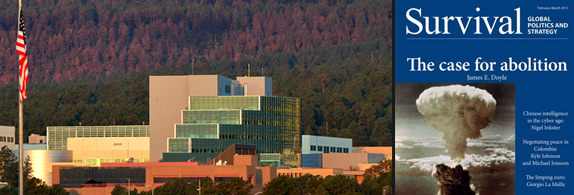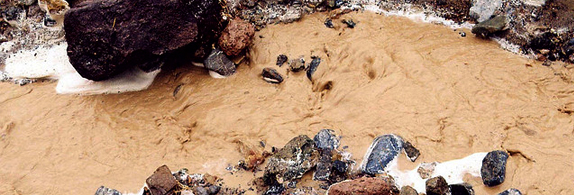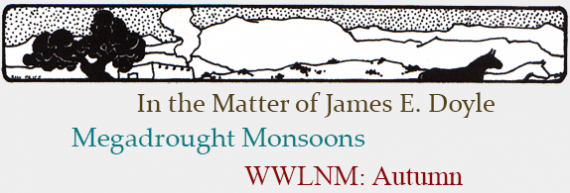In the Matter of James E. Doyle

Any time someone gets roughed up because of something they’ve written, many writers who belong to the club of those who make their living speaking their minds think to themselves “There but for the grace of God go I.”
When someone loses their job because they are intelligent, reasonable, and supremely sane, that’s more worrisome than ever.
This is what’s happened to a New Mexican writer named James E. Doyle. He’s been fired from the Los Alamos National Laboratories (LANL) for publishing an essay in an international journal that advocated for the elimination of nuclear weapons in support of a position that President Obama expressed in 2009 when he said the United States seeks “the peace and security of a world without nuclear weapons.”
The President said that the “existence of thousands of nuclear weapons is the most dangerous legacy of the Cold War.”
LANL fired Doyle, after 17 years of his employment there, for publishing a piece that contained alleged “classified” information. Doyle told the Center for Public Integrity, a Washington based nonprofit investigative news organization, that “Classification has been used against me for the purposes of censorship of the article and retaliation against me for writing the article.”
Doyle’s case is currently under review by the Inspector General of the Department of Energy.
A careful reading of Doyle’s article reveals to me nothing in the way of a classified secret. I find myself agreeing with every word of it. And I am in no position to know a single thing about what LANL and the DOE considers classified information. Nor do I ever want to be. But Doyle’s right.
His essay appeared in Survival: Global Politics and Strategy, a publication of the London based International Institute for Strategic Studies (IISS). Doyle wrote “Banning the bomb has been a passionate and often popular crusade since its creation and first use, but in all that time it has never been a serious strategic objective for any state that possessed nuclear weapons.” Until President Obama declared that a world without nuclear weapons was a strategic goal for the security of the United States.
Doyle continues writing that “recent scholarship in the fields of history and deterrence theory questions deeply held beliefs regarding how nuclear weapons might influence the behavior of national decision-makers. For example, declassified official documents from the Cold War reveal occasions when nuclear catastrophe was avoided by luck or seemingly random events rather than by the clearly identifiable operation of nuclear deterrence.”
Doyle points out that “our greater understanding of the Earth’s environmental systems and humankind’s interdependence with those systems has made eliminating nuclear weapons more salient. A quite limited exchange of nuclear weapons against urban areas could trigger or accelerate global climate catastrophe (cooling rather than warming), leading to the deaths of millions who had been uninvolved in the conflict itself.”
Doyle says that no one questions the “catastrophic consequences” of a nuclear exchange. “The rapid destruction of even a small number of major urban areas in any nation would bring unprecedented devastation and loss of life. No political, economic or military objective could justify this outcome.”
And for this highly rational assessment James E. Doyle was fired from LANL even though his President has declared that a world without nuclear weapons is in the best national security interest of the United States.
I’ve never read a saner, more rational view of the irrationality of nuclear deterrence in a post-Cold War world dominated by globalized economic systems and the threats of terrorists that no one but a lunatic would consider nuking and taking along with them hundreds of thousands of civilians.
I admire Doyle’s argument. Not only is the use of nuclear weapons unthinkable, no one believes, he writes “that any human or technological device, system or tool will operate forever without failure or error.” Absolutely right!
Maybe Doyle was canned because he is too rational, too pragmatic, too realistic for a vast munitions installation like LANL to tolerate. He is, after all, advocating doing away with LANL’s chief function.
Doyle’s firing amounts to a serious mistake, and a deep flaw in LANL’s and the DOE’s sense of purpose, fairness, and openness to critical thinking.
I’ve always thought that nuclear weapons were insane, that humans and human systems are too bumbling and flawed to keep them from flattening cities by accident, that the idea of mutually assured destruction (MAD) was mad in itself, and that the use of even one nuclear device now would amount to the end of the world as we know it. I’ve written many times that the sooner we get rid of these hellacious weapons the better. The thought that many thousands of them are still on top of missiles, in submarines, and in planes all over the world is terrifying. Knowing something of the history of accidents and near misses involving nuclear weapons could keep anyone up at night. The thought that human fallibility will never come into play in the use of such weapons is absurd. The hazardous and radioactive waste they create is a menace to New Mexico and every place else in the world that has such materials.
I’m willing to concede that nuclear deterrence was a useful, if perilously dangerous, conception during the Cold War, and that without MAD the Cuban missile crisis, certainly the most horrific collective experience of my life, was to some extent averted by the possibility of nuclear Armageddon.
But Doyle is right when he says that there has emerged over the years something like “a powerful norm or taboo against nuclear use.” The nuclear taboo is based, he writes, “on the tradition of non-use, a growing understanding of the difficulty of achieving military aims with nuclear weapons and a deep moral revulsion to the indiscriminate destruction that nuclear weapons would bring upon human populations and the environment.”
American scientific institutions that don’t thrive on critical thinking and debate are not only an insult to the Constitution but also in danger of being intellectually obsolete. LANL is apparently such a place.
Megadrought Monsoons?

In the last five years or so, as carbon emissions build up in our atmosphere, we’ve seen in the desert southwest of New Mexico and Arizona a curious phenomenon – the replacement of snowpack by monsoonal flooding as a major source of water. The problem is that while we know what to do with snowpack we have not had the time, or perhaps the inclination, to adapt to serious flash flooding in the monsoon season.
Recent studies are suggesting a 50/50 chance for a 30-year long “megadrought” in Southern California and the rest of the Southwest. Does that also mean less and less snowpack but greater chances for flooding storms?
Might such gigantic rainfalls be our salvation once we learn how to put them to best use?
When eight inches of rain fell in Phoenix not three months ago and horrendous drought relieving flooding gorged the Pecos around Carlsbad this year and last, it’s not nuts to wonder what might happen if the watersheds of the Sandias and Manzanos were hit with massive amounts of water over short periods of time.
Would Tijeras arroyo, which drains some 100 square miles of those mountains, become ferocious and destructive, gouging out the arroyo, sending debris down into the river, unearthing buried toxic wastes from Sandia National Labs? Would the torrent carry off urban refuse from a landfill in the watershed, perhaps even tear out the parking lot and undermine the buildings of Mountain View Elementary School near where arroyo waters enter into the Rio Grande?
Would our flood control system in Albuquerque be up to the challenge of funneling huge amounts of water into the river? I’d say we’ve done an excellent job protecting the city from floods so far, but how well would our system of channels hold up under massive downpours?
A bigger question, though, is about sending mountain rain water into the river at all. Is that the best use of such water in a drought? Should we recognize that these huge fast floods are a new and major source for our water supply and could we develop systems to slow them down, allowing them to penetrate into the ground water?
These new conditions may be temporary, transient and fickle, or they could become the norm. We don’t know yet, but there’s a good chance that we can use the flood waters to recharge our aquifers and reconnect flood plains to the ground water we’ve diminished by overuse.
This is all so new that we’re not reading much about how to make use of these flood waters yet. We’ve built dams and canals and other wonders of engineering to use snow pack, but the monsoonal floods have caught us off guard despite having a regular monsoon season every year. Apparently monsoons are like most things involving climate change – regular patterns intensify, sometimes wildly, and change in the patterns and frequencies of their comings and goings.
But it’s still not known if the intensity of these new kinds of monsoons are actually tied to climate change. Despite the lack of solid data as yet, some experts are guessing that it is.
These huge amounts of water can be devastating. Heavy rains last month created flooding all over Eddy county, causing the drowning death of one oil field worker, and creating floods in Roswell, Artesia and Carlsbad.
At some point New Mexico will have to spend the money to create systems that allow this water to be contained, collected, and used to recharge aquifers by creating new and healthier flood plains.
The techniques used to slow down fast changing intermittent floods in watersheds are fairly simple and well known, similar to systems used 800 or 900 years ago in the Chaco Province of the Pre-Pueblo people. One can use so many devices -- check dams, big rocks, fallen trees tied together, anything that causes the water to slow down and disperse, giving it time to sink into the ground and eventually into the aquifer.
Making use of flood waters in urban areas, or flatlands, seems at once more challenging and fairly obvious. The water has to be moved to places that are designed to store it and allow it to sink into the ground.
While flooding can be deadly, I find it amazing to be living in a time when it’s possible that the way water comes to our landscape is changing dramatically right before our eyes. One source of water, snow pack, is receding and another, monsoons, may be taking up the slack at least to some degree. I hope we’re up to the challenge and are not just going to procrastinate and lose our opportunities in denial while precious water is both wasted and wrecking us because we’ve refused to believe our own experience.
Why We Love New Mexico – Autumn

One of the most cherished New Mexican moments is when we go, almost in a single day, from dragging through heat sinks of summer days and hothouse nights to being surprised by the first chill of the autumn equinox. That’s when the nox, the Latin for night, gets gorgeously close to being too cold for comfort.
Yes, there’s always the worry about what to wear to avoid being too steamy in the day and then too exposed to the brisk breezes of the evening. But walking on the UNM campus at night in October by Johnson Field you see soccer players running around in shorts and tee shirts and feel quite snug in your ratty old jacket, cold neck and all.
On early autumn walks along the ditches in Albuquerque we see branches on certain cottonwoods start to turn gold, there’s a slight grayish crispness to the green of the elms, the stalks and seed heads on some weeds turn a dark, blood-orange red. The arbor along the water that had transformed itself not five months ago from dark winter limbs to a verdant tunnel of green is on the verge of disappearing, but not quite yet. It still gives us shade from the bare autumn sun which, though objectively cooler, feels slightly hotter than even high summer sunlight.
The green frogs on the ditch banks are not making appearances until later in the afternoon we suspect. They don’t need meteorologists to tell them that the earth’s axis is tilted so the sun no longer hits the earth from a steep angle but has spread out into a more shallow angle which spreads out solar energy so it isn’t as intense as summer light.
The earth’s axis and its orbit combine to cause such wonderful oddities. The orbit and the axis sync in such a way that the earth is actually farthest from the sun, but hotter because of angle, in July than it is in January when the earth is closest to the sun but angled in such a way that, in the northern hemisphere, the sun rays are defused.
In October I always return to Winfield Townley Scott’s wonderful essay “A Calendar of Santa Fe,” published in l961 in his collected essays Exiles and Fabrications.
He wrote in the section on October:
In this staggering spaciousness of earth and sky, light is the vital force, the nervous or majestic rhythm, the master painter. In October the late-afternoon light performs dramatic things. It will turn the Jemez Range into a two-dimensional colossal backdrop, pigeon-indigo. It fires all the ridges of the foothills while shadows fill up the infolding erosions. And at that time of day if you drive within the Sangre de Cristo Mountains, you repeatedly drive into deep shadows and yet always with ways east or south to see out, as it were, to other peaks blazing in sunlight. The golden aspens quiver along the amazing blue intersections of the sky.
I love waking up in the cold. I put on three layers of shirts this morning when the house was down to 67.8 degrees. We’re waiting until it gets quite a bit colder to start spending money on the gas heater. But there will probably be a fire in the wood stove this weekend. And I’m about to order another half a cord of wood that should last two winters at least. We’re contemplating our fall garden, with greens for the winter and garlic and shallots for next spring. The Maximilians have exploded into a forest of yellow flowers. The outside cat is already starting to look a little like a Japanese woodcut of a man in what seems like ostrich feathers trudging up a mountain. By January, Mr. Face, as he’s known, will have fluffed out into a massive black ball with little white feet. Such is October in this little part of the North Valley, a time of small welcoming joys and delight in the thought of changes to come.
(Photos: Los Alamos National Labs by Larry Lamsa; Canyon flooding by Kai Schreiber; Fall cottonwoods by Robert Weber)




Responses to “Provincial Matters, 10-6-2014”